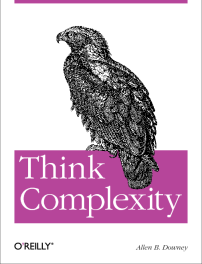
Think Complexity: Complexity Science and Computational Modeling, Second Edition
This book is about data structures and algorithms, intermediate programming in Python, complexity science and the philosophy of science.
Tag(s): Algorithms and Data Structures
Publication date: 12 Mar 2012
ISBN-10: 1449314635
ISBN-13: 9781449314637
Paperback: 160 pages
Views: 21,929
Type: N/A
Publisher: O’Reilly Media, Inc.
License: Creative Commons Attribution-NonCommercial-ShareAlike 3.0 Unported
Post time: 09 Jun 2009 09:38:15
Think Complexity: Complexity Science and Computational Modeling, Second Edition
 This book is about data structures and algorithms, intermediate programming in Python, complexity science and the philosophy of science.
This book is about data structures and algorithms, intermediate programming in Python, complexity science and the philosophy of science.
Publication date: 12 Mar 2012
ISBN-10: 1449314635
ISBN-13: 9781449314637
Paperback: 160 pages
Views: 21,929
Document Type: N/A
Publisher: O’Reilly Media, Inc.
License: Creative Commons Attribution-NonCommercial-ShareAlike 3.0 Unported
Post time: 09 Jun 2009 09:38:15
Share — copy and redistribute the material in any medium or format
Adapt — remix, transform, and build upon the material
The licensor cannot revoke these freedoms as long as you follow the license terms.
Click here to read the full license.
Allen B. Downey wrote:This book is about data structures and algorithms, intermediate programming in Python, complexity science and the philosophy of science:
Data structures and algorithms:
A data structure is a collection that contains data elements organized in a way that supports particular operations. For example, a dictionary organizes key-value pairs in a way that provides fast mapping from keys to values, but mapping from values to keys is generally slower.
An algorithm is an mechanical process for performing a computation. Designing efficient programs often involves the co-evolution of data structures and the algorithms that use them. For example, the first few chapters are about graphs, a data structure (nested dictionaries) that is a good implementation of a graph, and several graph algorithms that use this data structure.
Python programming:
This book picks up where Think Python leaves off. I assume that you have read that book or have equivalent knowledge of Python. As always, I will try to emphasize fundmental ideas that apply to programming in many languages, but along the way you will learn some useful features that are specific to Python.
Computational modeling:
A model is a simplified description of a system that is useful for simulation or analysis. Computational models are designed to take advantage of cheap, fast computation.
Philosophy of science:
The models and results I will present raise a number of questions relevant to the philosophy of science, including the nature of scientific laws, theory choice, realism and instrumentalism, holism and reductionism, and Bayesian epistemology.
There are two kinds of computational models:
Continuous:
Many computational models compute discrete approximations of equations that are continuous in space and time. For example, to compute the trajectory of a planet, you could describe planetary motion using differential equations and then compute a numerical approximation of the position of the planet at discrete points in time.
The fields of numerical methods and scientific computing tend to focus on these kinds of models.
Discrete:
Discrete models include graphs, cellular automata, and agent-based models. They are often characterized by structure, rules and transitions rather than by equations. They tend to be more abstract than continuous models; in some cases there is no direct correspondence between the model and a physical system.
Complexity science is an interdisciplinary field—at the intersection of mathematics, computer science and physics—that focuses on these kinds of models.
And that’s what this book is about.
Tweet
About The Author(s)
Allen B. Downey (born May 11, 1967) is an American computer scientist, Professor of Computer Science at the Franklin W. Olin College of Engineering and writer of free textbooks. Downey received in 1989 his BS and in 1990 his MA, both in Civil Engineering from the Massachusetts Institute of Technology, and his PhD in Computer Science from the University of California at Berkeley in 1997.

Allen B. Downey (born May 11, 1967) is an American computer scientist, Professor of Computer Science at the Franklin W. Olin College of Engineering and writer of free textbooks. Downey received in 1989 his BS and in 1990 his MA, both in Civil Engineering from the Massachusetts Institute of Technology, and his PhD in Computer Science from the University of California at Berkeley in 1997.